Have you ever been confused about the difference between water-bath canning and pressure canning? Huge thanks to one reader who pointed out she didn’t know all of the canning terms and equipment.
So for those of you new to canning or even seasoned-pros, I hope to share the basics and tips in Canning 101, to make your canning adventures as easy and successful as possible.
Water-bath canning is processing your canned foods in boiling water for a specified amount of time. Acidic foods can safely be canned via the water-bath method. These are jellies, jams, preserves, marmalade, fruits,fruit spread, fruit sauces, tomatoes (with acid added via lemon juice or vinegar), pickles, relishes, and chutneys.
🍞 Struggling With Sourdough?
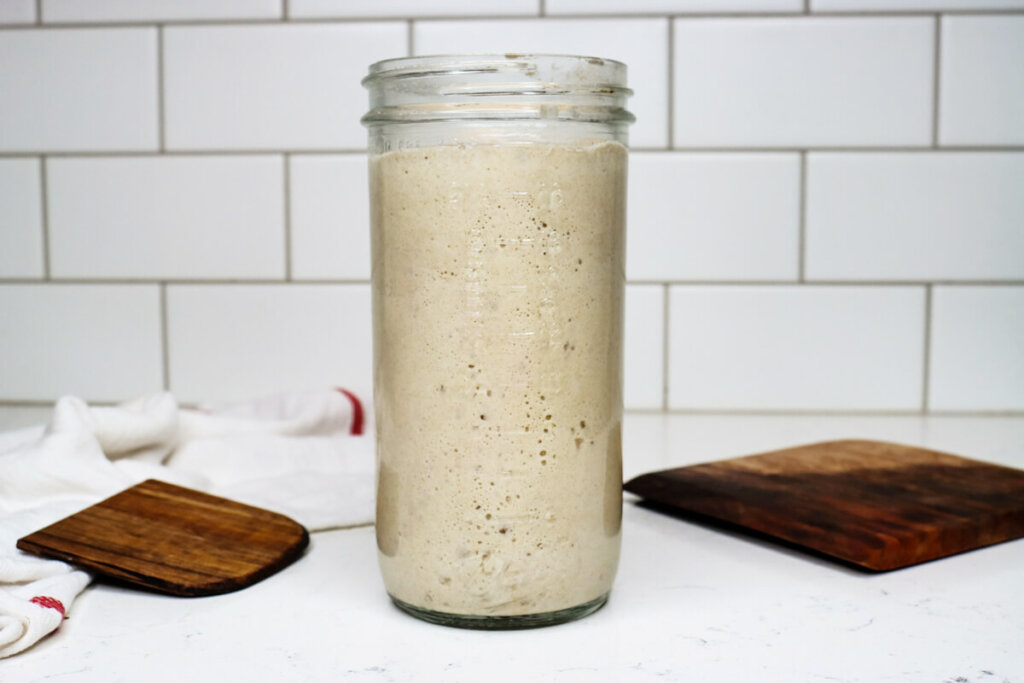
If your starter won’t take off, your loaves are dense and hard, or sourdough just flat-out overwhelms you…
👉 I’ll show you how to fix all of it.
Join my FREE live workshop and learn how to make a bubbly, active starter—the right way, from Day One.
🗓️ Jan 12 @ 1pm PT
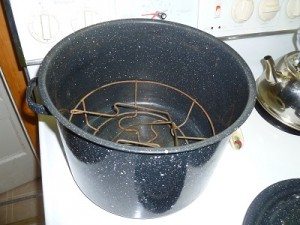
Pressure canning heats your canned food under steam pressure, allowing for much higher temperatures and faster cooking times. All low-acid foods must be canned using a pressure canner. Low acid foods include vegetables, meat, poultry, seafood, and combination recipes.
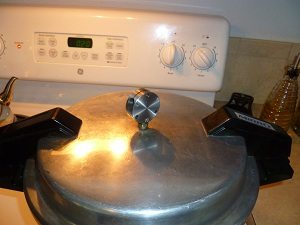
I know people used to can with just the water-bath and may have not experienced problems. But newer strains of tomatoes don’t have the acid levels and unless you can check the ph level at home, I wouldn’t risk it. Growing and preserving your food is rewarding but hard work, I’d rather know it’s done safely and correctly using these guidelines.
Time-saving tip- I also use my pressure canner to can my applesauce, though you can use a water-bath because this is acidic food. One of the benefits to the pressure canner is you can raw pack all of your vegetables and fruits. It will cook fully while it’s being canned.
Wash your jars, lids, and bands in hot soapy water and rinse well. You can keep your jars heated in hot water in your canner, but I keep mine in the hot wash water until I’m ready to fill them. New canning guidelines no longer require to pre-heat the lids, juts put them on cold. (If water-bath canning for less than 10 minutes processing, sterilize jars by boiling them for 10 minutes beforehand)
Pint-sized jars are two cups and quart jars hold four cups. Make sure your pressure canner holds both sizes so you only have to make one purchase. See 5 Tips for Choosing the Best Pressure Canner for You
Table of Contents[Hide][Show]
Proper Headspace for Canning
Fill your jars with the prepared recipe. If raw packing your fruit and vegetables, pour your boiling water or syrup over raw fruit/vegetable. Leave 1/4 inch headspace for fruit juices, pickles, jams, and jellies(space between top of jar and your food) 1/2 inch for fruits and tomatoes, 1 inch for vegetables, meats, poultry, seafood, and combinations recipes.
Remove air bubbles by sliding a spatula between the side of the jar and your food. Run it around the outside of the jar and tap on the top of the food.
Wipe the rim and threads of the jar with a damp, clean cloth. Place lids on jars, screw band down until resistance is met. Don’t over tighten.
Place jars in the canner. Be sure the rack is inside, this keeps the jars from sitting directly on the heat source or bottom of the pot. If jars aren’t on the rack, they can become too hot and burst or crack. For water-bath make sure the water covers the top of your jars by at least 1 inch of water. Follow the amount of water your manual suggestions for your pressure canner, more is better. Mine calls for a quart and a half.
Start the timer for your recipe when the water is at a full boil for water-bath or when the pressure control starts to jiggle. For pressure canner, you’ll need to lock your lid into place, but don’t put the pressure control on yet. Allow steam to come through the vent for 10 minutes. This allows the pressure to build and the air to exhaust, very important so don’t skip this step. Then select the correct pounds of pressure and put your controller in place. Once it begins to jiggle and hiss, at least 3 to 4 times per minute, start your timer.
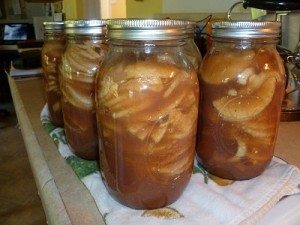
When time is up, allow canner to cool according to the manufactorer’s guide. Carefully remove jars, with either a jar lifter (will save those fingers) or using an oven mitt. Set warm jars on a double folded towel. Allow to cool for 12 to 24 hours without moving.
After jars are cool, test the lids for a seal. Press the center of the lid with your finger. If it doesn’t flex, jar is sealed. Remove band and store in a cool, dry, dark place like a pantry shelf. If it does flex, you may try and re-seal or place in the fridge to eat!
Do you have any canning tips? For information on other food preservation methods, check out 10 ways to preserve food at home.
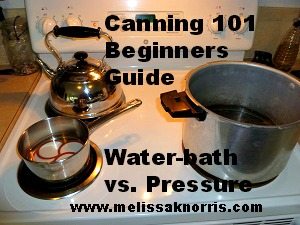
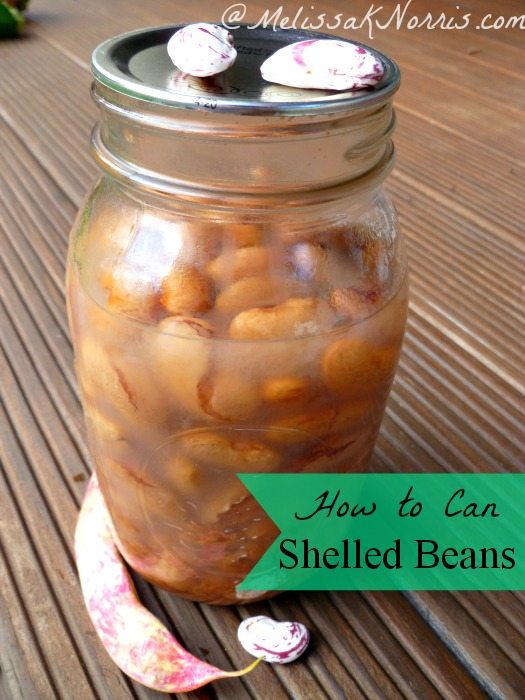
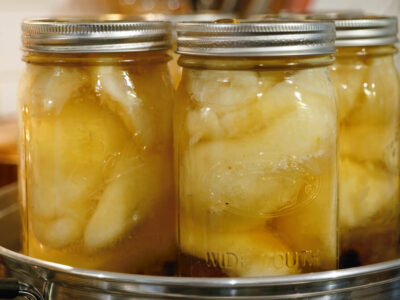

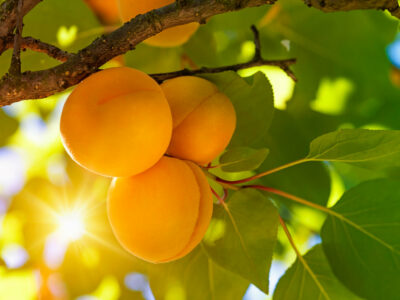






Do you have any information on steam canning? Can all the items that are water bathed basically be steam canned?
I followed a veg soup recipe. 3 hours in water bath. is this ok
No, it’s definitely not okay. Vegetables have to be pressure canned in order to reach high enough temperatures to kill botulism spores, boiling water never gets higher than 212 degrees F (temp of boiling water) no matter how long you boil it. Unfortunately you should dispose of that soup. I have a free pressure canning and safety series here I think you’d find very helpful https://melissa-norris.mykajabi.com/pressurecanning
I’ve been canning tomatoes, for about 10 years now in water bath like my mother does, and no problems. I have even been using jars that are 3 years old this year, still good. I use Early Girl.
It’s fine to can tomatoes in a water bath because they’re not a vegetable, they’re a fruit, but you do still need to add some form of acid to them, either lemon juice or citric acid. I have jars that are over 20 years. 🙂
Re: pressure canner vs boiling water bath: What am I missing? I am not new to canning, but I am new to this notion that one needs a pressure canner to safely can low acidic foods. I have canned carrots and beef with a boiling water canner and haven’t had a single issue; and I’m not alone in this. When and where did this idea start? I see most, if not all, of the websites/blogs that mention this also advertise pressure canners for sale. Hmm.
From testing and science and from people dying from botulism, a bacteria that can be fatal and thrives in areas without oxygen (a sealed canning jar) and in non-acidic environments. Please do research before making an assumption, it’s not an idea but a fact. You may have not had issues, but you’re taking a huge risk and one I wouldn’t gamble with my family with.
Hello,
When canning banana peppers should a pressure canner be used?
Thanks
I want to pressure can pickled ,Okra how many pounds of pressure for how long . Rather than 10 minutes water bath
Will contents of jars be tainted if tipped upon removing from pressure pot? Specifically tomato sauce? How long should jars be left undisturbed upon removal? Thank you so very much
Hi Marcia, no, they won’t be tainted if tipped, but it could affect them sealing, so if you can keep them as straight as possible when removing, that’s best. Leave them undisturbed for at least 12 hours if possible. You may want to sign up for our free home canning safety class here. https://app.webinarjam.net/register/35303/a59553d07a
I hope you can/will answer my question. I am still new to pressure canning, this being my 2nd year. Last year I made a beautiful base which I later pureed into cream of broccoli soup. I would like to put some up again this year, but am having trouble remembering what I did. I believe I raw packed the broccoli chopped up into nice chunks, added raw diced bacon, chopped onions and a small clove of garlic and topped it off with hot chicken stock to 1″ from the top. I think I processed my quart jars 90 minutes (the time required for the meat, bacon). The broccoli becoming too soft was not an issue to me as I pureed it and added the creams, etc when I opened it to cook and eat. Can you advise if this seems like a safe procedure? I asked “ball” but they could not seem to get past broccoli not being recommended as it gets too mushy. Any help/comments is appreciated.
Unfortunately, there are no safe tested times for broccoli and it’s not recommended for canning. I freeze or dehydrate broccoli, but not a canning one.
I have a small canning business making jams, pickles and relishes. I just pitchased a pressure canning machine and it says to use only recipes designed for pressure cannng. Do I have to change my jam recipes that I presently use a hot water bath for?
So, I am new to canning apples and making apple cider vinegar. How come applesauce needs to be pressure cooked and apple cider vinegar does not? Both use sugar water for the base?
Applesauce doesn’t have to pressure canned, it can also be water bath canned and apple cider vinegar is shelf stable without being canned. I don’t use a sugar water for either of mine.
I’ve just pressure canned two batches of applesauce. One in pints at 10lbs pressure for 8 minutes, the other in quarts at 10 lbs. for 10 minutes. Both batches turned brown throughout during processing. I did not add sugar–just a little salt. What went wrong? Should I add lemon juice or citric acid.
Several years ago I used water bath & it was beautiful. Can’t remember if I added lemon or citric acid. I’m trying not to add sugar so I didn’t want the added tartness of lemon. Thank you!
Susie,
It’s because you didn’t add any lemon juice or citric acid. The newer recommendations are to add lemon juice, as some windfall apples and varieties aren’t as acidic, as well as for color. The lemon juice won’t really make it anymore tart, it’s a small amount overall.
I always thought that you had to turn the jars upside down after processing in order for them to seal properly.
No, that’s not needed with proper processing, it could actually inhibit a good seal. An old unsafe method of canning called jar flipping or immersion canning (or open kettle canning) was to fill the jar with hot liquid, not process it in a water bath or pressure canner, to seal the lids. This is very outdated and unsafe as processing is what kills harmful bacteria spores so they can’t grow.
Is there a source or method for calculating timing & pressure weight for using a pressure canner in place of using a water bath canner? Such as canning applesauce or pearsauce?
My pressure canner came with a manual that has the times, for applesauce it’s 5 pounds of pressure and 8 minutes for pints and 10 minutes for quarts.
I read our apple pie filling recipe to pressure cook and cool appropriately but my question is how long can I keep it in the closet?
After it’s canned I’ve had mine for up to two years in the pantry.
Is there a difference in “shelf life” in both canning methods? What kind of “shelf life” does any fruit or vegetable have?
In case you can’t tell we are new to canning. We did the hot water bath method for blueberries, cherries, apricot and raspberries.
Hi John, no, the shelf life is the same for both water bath and pressure canning. If you’re new, you might want to sign up for my free home canning class here. https://app.webinarjam.net/register/35303/a59553d07a
Why is it that tomatoes area always supposed to be pressure canned? Isn’t pressure canning for low acid foods? Tomatoes are not low acid. Are there other reasons? Thanks.
Wendy,
Tomatoes are border line for being acidic. Because most people don’t have a way to check acid levels at home, you have to add either lemon juice, citric acid, or vinegar in order to safely can them (this even applies to pressure canning times if it’s just tomatoes and not in a combination recipe). You can safely water bath tomatoes by adding the form of acid and following the correct time. I personally find it faster to raw pack my tomatoes and pressure can them.
I love canning. I save a lot of time by pressure canning my dried beans all kinds get canned ,so easy when you’re in a hurry for beans and rice dinner
Hi Melissa
Thank you for the information on water bath to a canner. I have had my water bath for nearly 30 years and have had a couple of failures, mainly potatoes that pop the lid. I have been saving for a canner but wanted as much information on them before I buy myself one.
I only grow Heritage Tomatoes as they taste like real ones not the watery ones from shops. I make my own sauce and I also dry them. For soups I freeze them whole and not use any liquid as the frozen ones have enough to use.
Again thank you for your artical.
cheers Robyne
Robyne,
So glad you found it helpful, you probably had lid failures on the potatoes because they really do need to be canned in a pressure canner. Heritage tomatoes are the best, right? So much more flavor.
This was a timely article. I just canned applesauce and apple pie filling. It said to use water bath canning, but I used the pressure canner. I wondered if there was any reason not to use pressure canning. Thanks for your articles. Your email is one I look forward to every day. God Bless.
Sandi,
Thank you! Happy to hear you’re canning and glad you found this helpful.
My mom and older sister didn’t have racks, so they put dishtowels on the bottom of their water bath pots to protect the jars. They never had a jar break.
Donna,
I’ve done that, too! You can also use old bands on the bottom to life the jars up as well. Great tip!
Most pressure canner say specifically NOT to use on a glass top stove. The weight can crack the tops AND the element cycles on and off which messes up the consistency of your pressure levels.
Caryl,
There are a few specific brands that are made for glass top stoves.
im new at canning and I recently bought a pressure canner 16qt size rather than a water bathing canner due to lack of head space and I have a glass top stove . My question is may I do my jams with my pressure canner and have them turn out as good as with water bathing process?
Kathy,
If the pressure canner is deep enough you can use it as a water bath without sealing it. However, I’ve never pressure canned my jam and jelly. I do my applesauce, apple pie filling, tomatoes, and other fruits, but not jam/jelly or pickles.
[…] as it thaws. In order to do this I always try to keep a years worth of canning lids on hand. (My Canning 101 water bath vs. pressure canning tutorial and other canning […]
[…] sure about the difference between water bath and pressure canning? Check out this post on water bath vs. pressure canning for the nitty gritty […]
[…] learn more about home canning read my post on Waterbath Canning vs. Pressure Canning and listen to Home Canning 101 with 7 of my canning recipes to get you […]
[…] learn more about home canning read my post on Waterbath Canning vs. Pressure Canning and listen to Home Canning 101 with 7 of my canning recipes to get you […]
Correction: A pint is 2 cups and a quart is 4 cups.
Elaine, you’re absolutely correct. Fixing that now. 🙂